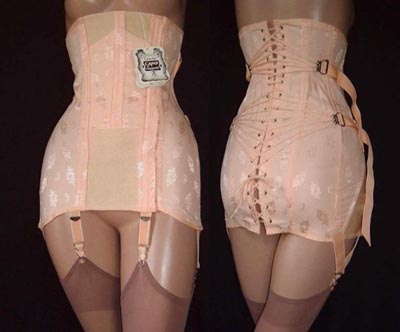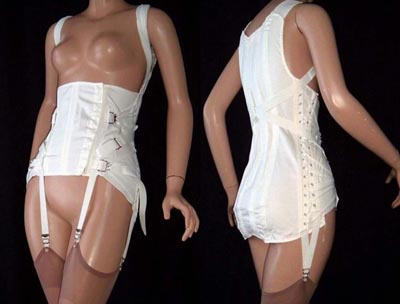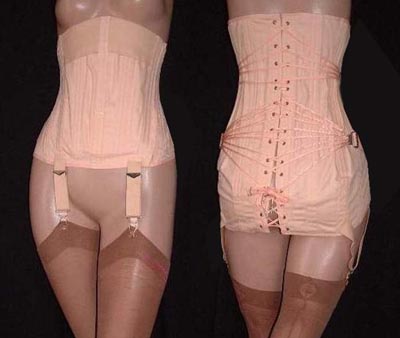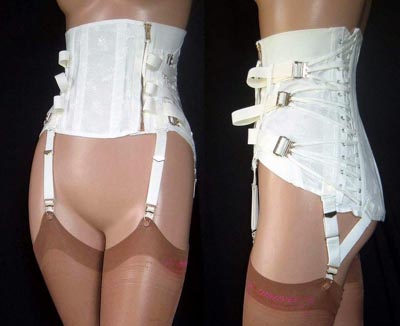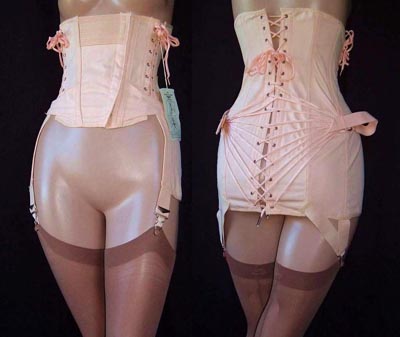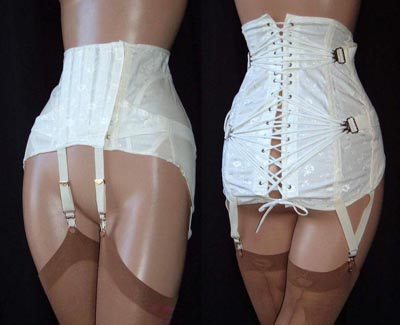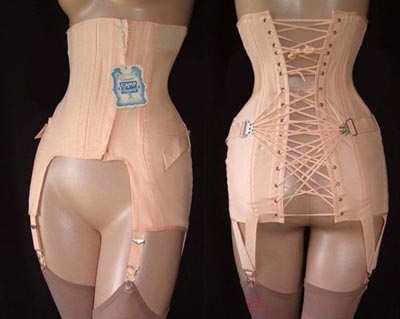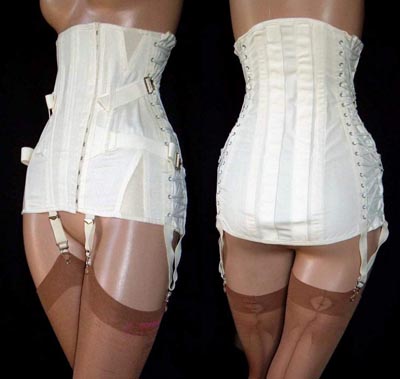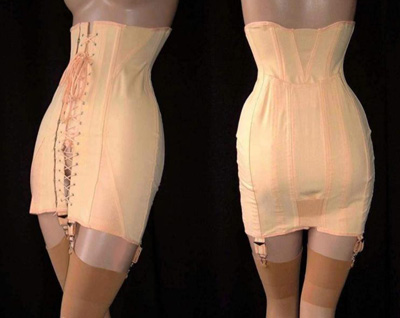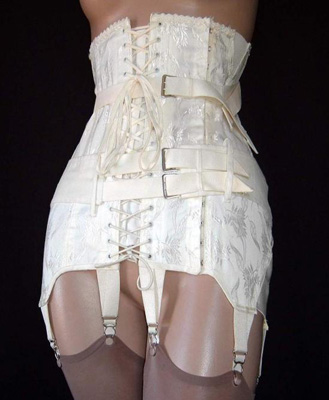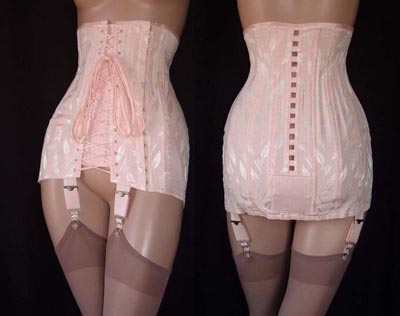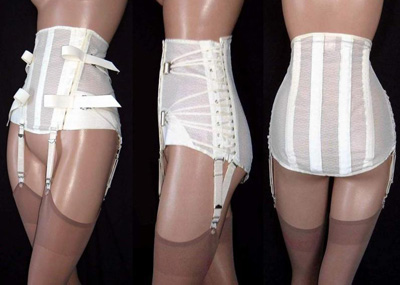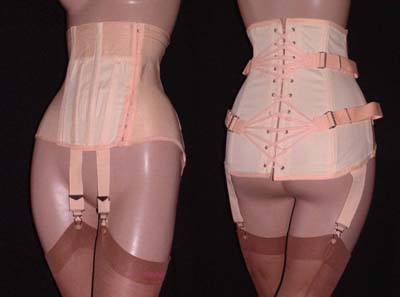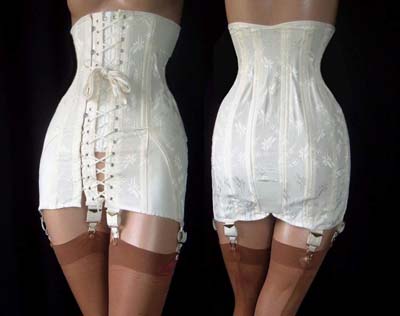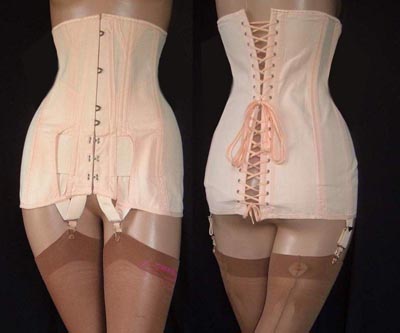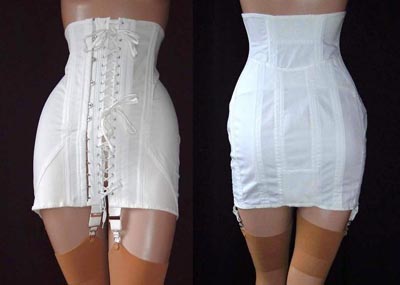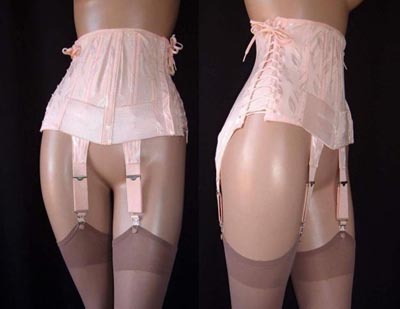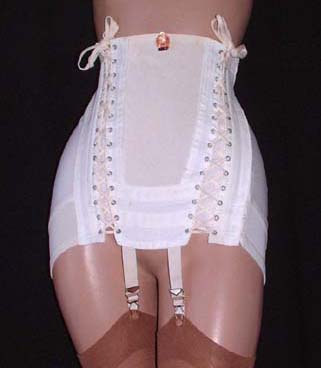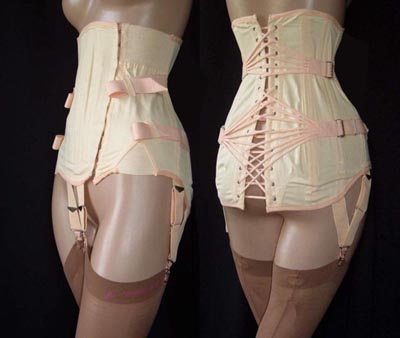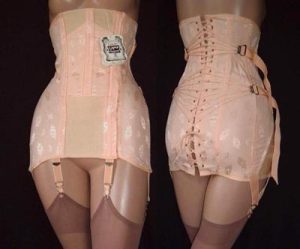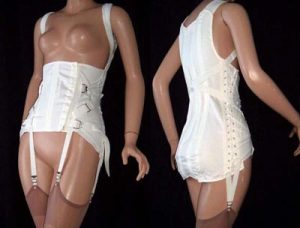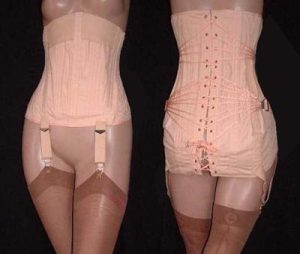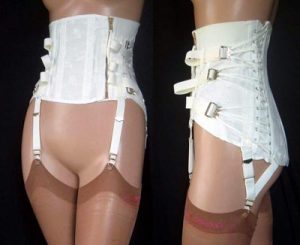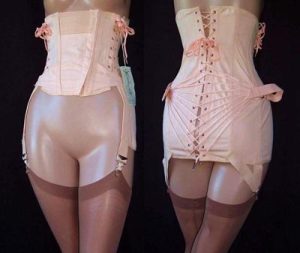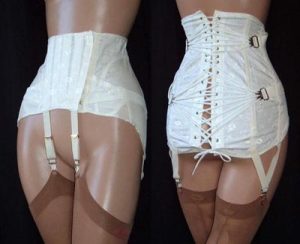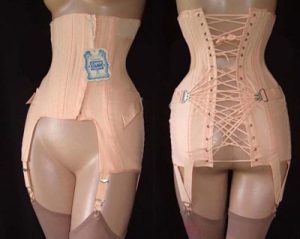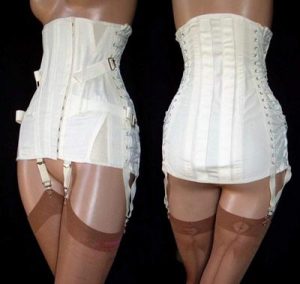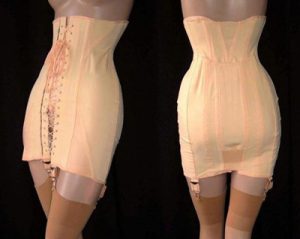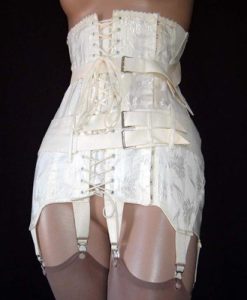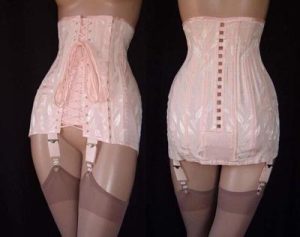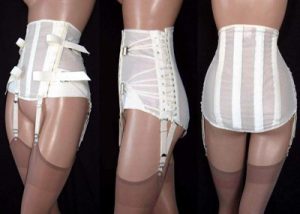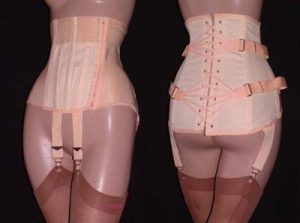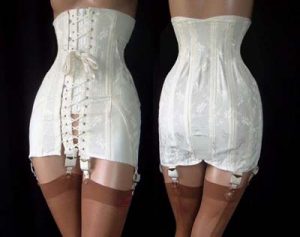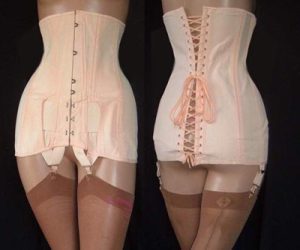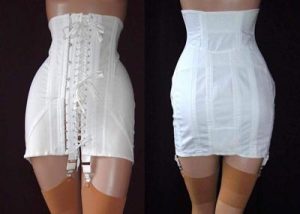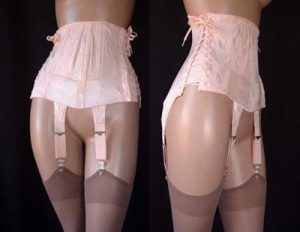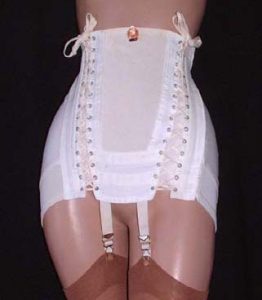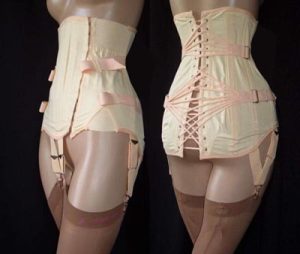1920s Corsets
Perhaps as a reaction to the sobering effects of the austerity measures and casualties of the Great War, women’s fashion began to evolve into simpler lines.
Looser shapes, with a straight though silhouette from shoulder to hem became the norm. Whilst the new fashion allowed more freedom of movement, it would also require a new style of corsetry.
The beauty ideal was to have slim hips and thighs and a healthy boyish figure. For many women this new silhouette was difficult to emulate and corsetry was vital to keep up with the current fashions.
Corsets became very long, and were designed to slim the hips and thighs as much as possible. Worn under the bust through the mid-thigh, they had multiple garters for connecting to stockings. The garters served to tension everything together into a perfect smooth straight through line.
Fabrics used include Coutil, Silk Brocade, and Batiste for summer Corsets, Woven Elastics and Cotton Sateen often used in conjunction with insets and/or panels of elastic for movement. Fastenings were commonly a straight front busk with back lacing. Front laced corsets usually had a smooth back with either an elastic panel at centre back, or elastic insets at top and hem. Corsets of the period were often still heavily boned, with stays at front side and back.
Also available in the 1920s were ‘Sports’ Corsets and Hip Confiners. These simpler styles of corsets were designed for more youthful, slimmer figures. These were designed for a lower bust line, with lighter boning often at just front and back, and incorporating more elastic panels for freedom of movement. These were commonly worn with Bust Confiners and Camisole style Brassieres.
By the late 1920’s the Berlei Company, founded in Australia, launched their Figure Type Indicator System, making it easier for every woman to purchase the correct type of corsetry for her particular figure.
1930s Corsets
By the 1930’s Fashion starts to change, with a slightly more fitted silhouette emerging. The figure emphasise continued to be on slim hips, but with a suggestion of waistline emerging. Garments continued to have a dropped waist line and were often cut with angled seams, and wider hemlines, incorporating gores, godets and pleats.
Corsets continued to be a long mid-thigh length, but began to include built in brassieres, evolving into all in one foundation garment. These foundation corsets usually had side hook and eye fastenings and hidden heavily boned inner girdles or belts.
These internal girdles were made in Coutil, Rayons, Cottons, woven elastics, and cotton covered rubber. The outer garments were made in Rayon and/or Cotton satins, Coutil, rayon jersey, Cotton brocade, and in double layer Cotton Voile for summer styles. The fastened with front busks, side hooks or front lacing. Some models also had back lacing for additional support and figure reduction.
Girdles also were available in the 1930s- made in coutil, rubber, rayon, brocades and cotton brioche and elasticated fabrics. With Side Hooks, Front Busk Fastenings or lacing these were often heavily boned and usually high waisted with side panels in elastic fabric. More youthful models incorporated more elastic panels and a lower waistline.
1940s Corsets
With WW11 declared in Europe in 1939, it would not be long before austerity measures were introduced, that deeply affected the fashion industry, and along with that the Lingerie Industry.
Luxury fabrics were hard to obtain or prohibited, and the era of Make Do and Mend began. Zippers were prohibited for use in corsetry and steel hook and eye closures were limited. This increased the use of lace up fastenings, and elastic fabrics, whilst rubber was no longer available for use in clothing. This led to more emphasis on function rather than good looks, and the actual pattern and cut of corsets with less reliance on metal stays to shape the figure. Metal was clearly to be used in the war effort- not in your corset or girdle.
Many corsetry manufacturers pitched the importance of wearing correct corsetry on the war effort to stay in business. How else were women expected to work long hours in arduous jobs without the correct abdominal support.
Meanwhile, the shape of corsets continued to change. With brassieres now the norm, More women wore girdles and waist corsets. Although similar in construction to 1930s corsets, the emphasis was now on a more clearly defined waist and Hip. This would become more and more extreme as the decade progressed.
Girdles were often made in stretch fabrics, such as neoprene synthetic elastic (rayon/cotton) Satin elastic, and rayon and cotton jerseys. Corsets in Rayon brocade and Coutil had elastic insets, front busks and lacing.
The one piece foundation garment continued to be worn, often designed for the more mature or full figured woman.
When the war ended in 1945, it was time for a breath of fresh air after years of going without. Although rationing continued in most countries, by 1947 Christian Dior was able to revolutionise fashion by launching his New Look collection in Paris. The collection was a huge success, and would be copied all over the world. The wide hemlines, nipped waists and feminine designs were in complete contrast to the frugal cut and finishing of the fashions during war time.
With the new fashion silhouette requiring a tiny waist, full hips and high full uplifted bust, the corset was about to become a necessity all over again. The waist Waspie was a solution for many women, in elasticized fabrics such as nylon and cotton, using stays to narrow the waist to the ideal of just 20 inches.
1950s Corsets
From Bullet Bras to Corsets the iconic 50s silhouette is still popular and sought after today.
Corsets now had to work very hard to create the right shape for the customer. By 1952 in America Warners had launched the famous Merry Widow Corselet which combined the sleek lines of a girdle with the wired cup and shape of a bullet bra.
Christian Dior licensed their ready to wear Lingerie range to companies Worldwide, such as Symington Corset Company in the UK.
The longer line corselets of the 50s ensured the bust projection, small waist and full hip required for the fashion of the time. Strapless, underwired and low back necklines were all available, along with a vast range of colours and styles.
The use of new 2 way stretch fabrics and stretch net, in conjunction with technically complex panels and elasticated inserts made 1950s corsets able to transform most figures. By the early 1960s the introduction of Lycra would further revolutionize the Lingerie industry.
Less glamorous but super effective, were Designs such as those manufactured by Camp Corsets. With cleverly designed fan lacing, buckles and serious steel stays, many women achieved their wasp waists with these iconic corsets. Meanwhile in Australia, The House of Jenyns established in 1891 was producing its own patented fan lacing corset including a satin version. In the United Kingdom the Company Spirella thrived in the 1950s by expanding its existing door to door sales of its corsetry products using trained corsetieres, thus ensuring the new fashion silhouette was accessible to women of all ages and sizes, in the privacy of their own home.
1960s -1970s Corsets
The introduction of Spandex and subsequently Lycra transformed foundation garments in the 1960s. With the new two way stretch materials that held there shape, there was no longer the need for hook and eye fastenings, as roll on girdles gained popularity.
Available in wide ranging colour options, the girdle and pantie girdle overtook the corset as the foundation garment of choice. Comfortable Lycra based items such as body suits became widely available.
Pantie girdles came in short and long styles, and often had detachable garter clips to connect to stockings. The introduction of pantihose and tights would further change the future of traditional corsets. The era of the Youth market had arrived, as had the Swinging Sixties. Miniskirts and Hot Pants made traditional corsetry redundant to younger women, and the concept of freedom in every aspect of life became the norm amongst the youth of the day.
Meanwhile companies such as Camp and Jenyns continued to produce its 1950s styles- to a loyal established client base that clung to the firmer support and traditional styling of their products.
Corsets (including those by Camp and Jenyns) were still of appeal to the fetish market, exploited with humour by the Film Barbarella in 1968.
But to the average young women in 1970s Corsets were firmly a thing of the past.
1980s – Present day Corsets
London Street fashion gave corsets a new start in the 1980s, as Vivienne Westwood and partner Malcolm McLaren popularized fetish wear amongst the emerging Punk Scene. Westwood later embraced the concept of underwear as outer wear, and began designing corsets as key components of her solo collections. This trickled down to everyday fashion and was widely copied from street fashion to high street chain stores. The re-emergence of the popularity of Vintage clothing at the same time, led to a new interest in corsets, and for collecting and wearing vintage lingerie.
By 1990, Madonnas Blond Ambition tour with the legendary costumes designed by John Paul Gaultier cemented the popularity of 1950s style corsetry. This look was widely copied at the time. The rise of the Burlesque movement this century has encouraged a new generation of young women to explore wearing corsetry again.
Written by sewingmachinegirl
